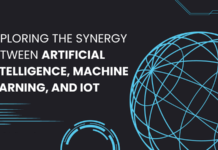AI is a branch of computer science that gives machines the ability to mimic human thought, decision making and behavior. The machines learn and adapt according to large datasets, eventually allowing them to make insights, predictions and recommendations. This technology has slowly been incorporated into different components of our everyday lives including in online chat bots, facial recognition software and self-driving cars.
The potential for AI in sales is huge, but yet to be fully unlocked. It can be used by businesses for price optimization, improving lead volume, closing rate, and revenue performance by helping automate much of the process. Salesforce also found that high-performing teams are 4.9X more likely to be using AI than underperforming ones.
How is AI used in sales?
- Predictive forecasting – Artificial intelligence systems may already predict or anticipate outcomes based on past data to help shape future results. Sales AI technologies are capable of making predictions like if a sale will close depending on previous consumer patterns. Having a better understanding of what the future demand of your business looks like, will allow you to appropriately allocate resources where it is best spent. Further, another key benefit is being able to holistically understand your customers better – knowing why they have certain behaviours. Having and using this information will greatly improve customer retention in the future.
- Lead scoring – AI will help you determine behaviours of leads and in turn the probability that they turn into a paying customer. This means that with AI, you will better be able to improve your lead generation because you can score your prospects and effectively determine how you want to approach and prioritise them based on their level of interest.
- Content personalisation – Understanding your priority leads will help you curate personalised content to attract them. Content may be in the form of webinars, white papers and blogs.
- Recommendations – AI can help provide recommendations on the best action based on a combination of the lead themselves and your company goals. Actions that it may recommend include probability of making the sale and who to prioritise. This can save the time of your sales team, allowing them to spend more time building relationships with prospects.
- Automation – AI can help automate repetitive tasks for your sales team. This includes tasks such as inputting data into your CRM, setting up meetings and answering generic questions via a chatbot.
- Analytics – AI can give your sales team strong analytical data. One example is that you can better understand the success of your sales team by using AI to give proper attribution to each sale. You can also use AI to analyse customers, your tool and your pricing.
It’s clear that your sales team will not be replaced, but rather the role of your sales team will change. Previously, the role of sales would have been spent trawling through lists to find prospects that they should prioritise and follow up on. Now, with AI, they can better spend their time on building stronger relationships with prospects.
What are the key benefits for your sales team?
- More tailored leads for your sales team
- Increasing time for sales people to spend more time on selling and develop better relationships
- Reduction in time to close
- Reducing costs through more automation
- Better management and allocation of time with forecasting
- Easier to upsell and create tailored pricing
What are the best tools for your sales team?
Some examples of the best AI sales tools on the market to use so you can start focusing on selling more. The benefit of each tool is highly contingent on the goals that your company wants to achieve. If you were looking to gain more leads, you would want to look into sales intelligence tools and if you were looking to better manage your time, scheduling tools would be of better use.
1. Sales Intelligence – Triggr
Triggr is a SaaS platform that allows B2B sales & marketing professionals to generate highly targeted lead lists at scale, complete with the contact details of the decision makers who matter.
2. Scheduling – Bizzabo
Bizzabo is an event management platform that can be used to host and schedule face to face and online events.
3. Forecasting – Xactly Forecasting
Xactly Forecasting is a platform used to forecast and plan for your future sales pipeline with tools to create visual dashboards and see trends.
4. Automation – Dooly
Dooly helps to close gaps in your selling, including the small admin and data entry tasks. You can sync notes from Salesforce to connect your team and other stakeholders.
How to start implementing AI?
AI solutions are increasingly accepted but there are roadblocks to properly implementing it into an organisation. Data is critical for AI and to have a successful integration of it, organisations will need a comprehensive data stream. This data stream will effectively need to track leads from the beginning and as they move into loyal customers to data around if they stop becoming a paying customer. Having this comprehensive set of data can be hard to attain at first. Thus, by first setting a specific goal of tracking sales attribution and taking small steps by collecting a specific subset of data will be a step in the right direction.
To properly integrate AI, different departments in your organisation need to be aligned. This includes management, your customer facing teams and your back office. Management needs to be aligned on the benefits of AI so that as final decision makers, they will buy into the tool. Your customer facing teams and your back office needs to be aligned as AI tools will often span across the whole organisation. There is often hesitancy to uptake these tools given the perceived threat of roles. To overcome this, organisations need to reiterate the idea that these tools do not replace individuals, but rather shift the priorities of your teams to more focused and relationship building tasks.
Sales processes that are highly optimized by AI and machine learning technology aren’t a distant prospect; they already exist. Pivoting to the use of these tools will change how your team works across, putting you ahead of competitors.







